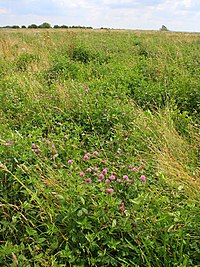
Photo from wikipedia
Black mustard [Brassica nigra (L.) Koch] is mainly cultivated as a seed crop, and there is a lack of information on biomass quality and its potential for animal feeding. A… Click to show full abstract
Black mustard [Brassica nigra (L.) Koch] is mainly cultivated as a seed crop, and there is a lack of information on biomass quality and its potential for animal feeding. A 2-year field experiment was set up in a split-plot design with 2 main plots (plant densities: 46 and 76 plants m−2), 4 sub-plots (fertilization levels: control, compost, urea with and without urease and nitrification inhibitors) and 3 replications for each treatment. The highest dry matter yield (17.55–18.34 tn ha−1) was observed in high-density plots fertilized with urea fertilizer coated with double (nitrification and urease) inhibitors. In terms of the qualitive parameters of total above-ground biomass, the highest crude protein (CP) content was achieved in plots with low density and urea with double inhibitors. Moreover, the highest neutral detergent fiber (NDF) and acid detergent fiber (ADF) contents of above-ground biomass were found under compost and urea with double inhibitors. The high ADF, NDF and relatively high CP content characterized that black mustard aerial biomass can meet the requirements of lactating animals, and therefore the production of black mustard biomass as a forage crop could be of great importance. As a conclusion, black mustard cultivated at plant densities higher than 46 plants m−2 and under inorganic fertilization, especially with urea coated with double inhibitors, could be successfully used as a novel forage crop in ruminants’ diets.
Journal Title: Plants
Year Published: 2022
Link to full text (if available)
Share on Social Media: Sign Up to like & get
recommendations!